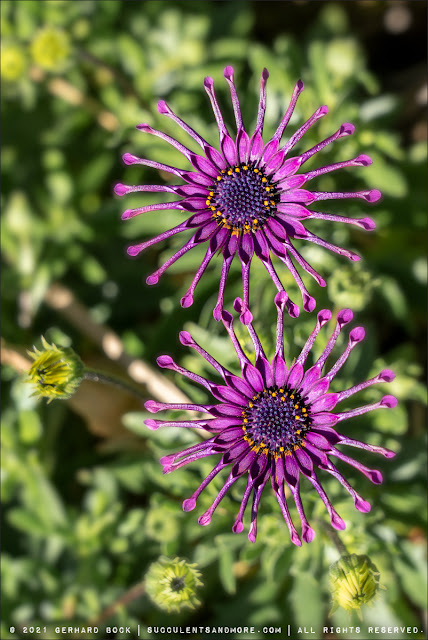I've been posting a lot of photos of flowering aloes lately, so let's take a break and look at some other February highlights. Of course it is possible that an aloe or two will sneak in—those buggers love photobombing!
 |
| Lachenalia aloides var. quadricolor looks right at home between cactus, agaves, hechtias, and a Dioon argentea |
 |
| Same vignette seen from the other side. Two hechtias on the left: Hechtia 'Silver Star' and Hechtia 'Oaxaca Sunset'. |
 |
| Hechtia argentea along the sidewalk pushing 5 (!) inflorescences. ×Mangave 'Red Wing' on the left, Yucca 'Bright Star' on the right. |
 |
| Newly planted Aloe vaombe in the front, Maireana sedifolia behind it, and Acacia aphylla peeking into the frame on the right |
 |
| Euphorbia characias 'Tasmanian Tiger' towering above the undulating foliage of Drimia maritima |
 |
| ×Mangave 'Mayan Queen' surrounded by Acacia cognata 'Cousin Itt', Salvia bullulata, and Felicia echinata |
 |
| Cephalophyllum stayneri, a cutting from a plant in the Ruth Bancroft Garden. The color is hard to describe; I've seen it referred to as cerise. |
 |
| Cephalophyllum stayneri |
 |
| ×Aloinanthus 'Opera Mauve' flowering for the first time. Look at the bumpy leaf surface! This is an intergeneric hybrid between Aloinopsis spathulata and Nananthus aff. broomii, two related ice plants. |
 |
| Yucca 'Bright Star' (left) and Osteospermum 'Astra Purple Spoon' |
 |
| Osteospermum 'Astra Purple Spoon', easily the most striking flowers in the garden right now |
 |
| Acacia baileyana 'Purpurea' and Grevillea 'Flora Mason', the latter putting on the best flowering display ever. I find the flowers hard to photograph; they're far more striking seen in person. |
 |
| Tradescantia 'Blushing Bride' in front of Homalocladium platycladum, which has the unfortunate common name of tapeworm plant |
 |
| Felicia aethiopica 'Tight & Tidy' (left), Oscularia caulescens (right) |
 |
| Prostrate form of Acacia glaucoptera in its winter red, with flower buds forming (the yellow bumps). The plant behind it is a Moroccan daisy (now Pyrethropsis hosmariense, formerly Rhodanthemum hosmariense). |
 |
| Aloe humilis × Aloe ferox (White Form), getting ready to flower for the first time |
 |
| ×Mangave 'Night Owl', the blackest mangave of them all |
While mornings are still brisk, afternoon temperatures are back in the 60s—and climbing towards the low 70s if the forecast can be trusted. Spring is so close, I can almost taste it!
© Gerhard Bock, 2021. All rights reserved. No part of the materials available through www.succulentsandmore.com may be copied, photocopied, reproduced, translated or reduced to any electronic medium or machine-readable form, in whole or in part, without prior written consent of Gerhard Bock. Any other reproduction in any form without the permission of Gerhard Bock is prohibited. All materials contained on this site are protected by United States and international copyright law and may not be reproduced, distributed, transmitted, displayed, published or broadcast without the prior written permission of Gerhard Bock. If you are reading this post on a website other than www.succulentsandmore.com, please be advised that that site is using my content without my permission. Any unauthorized use will be reported.






















What an explosion of colors and plant combinations in you post today. I'm loving Hechtia 'Oaxaca Sunset' in the rusty pot. Euphorbia 'Tasmanian Tiger' and Drimia maritima foliage make for a wonderful mix.
ReplyDeleteThank you! I wish I could say all these combinations are carefully planned out in advance. In reality, they're the result of my random approach to gardening :-).
DeleteLet's see, it was April of 2019 that I last saw your garden in person... a lot has changed since then! I think the Acacia glaucoptera is my most favorite in this post (which is saying something since it's chock full of gorgeous plants). Where is it located?
ReplyDeleteThe Acacia glaucoptera is at the very end of the long sidewalk bed, right next to the communal mailboxes.
DeleteLots of wonderful plants here! I adore Lachenalia and I'm determined to get hold of some of those bulbs this year. I think my garden is lacking a Hechtia or two as well. I'll be interested to know if the 'Purple Spoon' Osteospermum preserves its shape for you. All those I've kept from one year into the next seem to revert to a conventional petal form.
ReplyDeleteI honestly don't know why lachenalia aren't more common. Growers need to get on board!!
DeleteThis is year 2 or 3 for my 'Purple Spoon' osteospermums, and the petal shape hasn't changed. Weird that yours have reverted. I'll keep an eye on mine.
I can send you a few offsets from my Hechtia 'Silver Star'. I was given a second plant from San Marcos Growers, and I separated the offsets.
I never get tired of your Aloe pics but it's equally just as nice to see your other xerics! Your planting is fabulous and you have loads of fine specimens. Aloes and Agaves aside, that x Mangave 'Mayan Queen' is just gorgeous!
Delete'Mayan Queen' has lived up to its name. I'm hoping 'Aztec King', planted this winter, will be equally impressive (supposedly much bigger).
DeleteThanks so much for your documenting of this garden. I went on a walk through Piedmont and we quickly went by this garden. I could have spent an hour looking at all the dense plantings. Beautiful.
ReplyDeleteThis is actually my garden, not in Piedmont. Thank you for your kind words!
DeleteSo many choice plants, and they all look great. The super tubercle-y Aloes are way cool. humilis x ferox, wowza what a size differential between those two species!
ReplyDeleteThe seeming incompatibility of Aloe humilis and ferox are what attracted me in the first place. It looks the hybrid inherited the best of both parents!
Delete